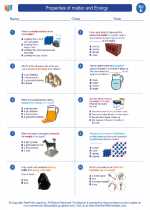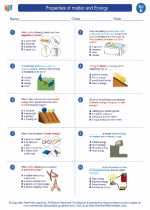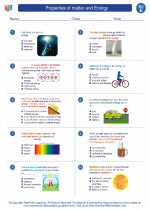Properties of matter and Energy -> wavelength
Wavelength
Wavelength is a fundamental concept in the study of waves, including sound waves, light waves, and water waves. It is defined as the distance between two consecutive points of a wave that are in phase with each other, such as two adjacent peaks or troughs.
Characteristics of Wavelength
- Symbol: λ (the Greek letter lambda)
- Units: Wavelength is often measured in meters (m), but it can also be measured in other units such as nanometers (nm) for light waves.
- Relation to Wave Speed: The wavelength of a wave is inversely proportional to its frequency, according to the equation: wavelength = speed of the wave / frequency.
- Color and Wavelength: In the case of light waves, different wavelengths correspond to different colors. For example, red light has a longer wavelength than blue light.
Examples of Wavelength
Here are some examples of wavelengths in different types of waves:
- Sound Waves: The wavelength of a sound wave determines its pitch. Longer wavelengths correspond to lower pitches, while shorter wavelengths correspond to higher pitches.
- Light Waves: Different colors of light have different wavelengths. For example, red light has a wavelength of approximately 620-750 nm, while blue light has a wavelength of approximately 450-495 nm.
- Water Waves: The distance between successive crests or troughs of a water wave represents its wavelength.
Study Guide
To understand and master the concept of wavelength, consider the following study guide:
- Learn the definition of wavelength and understand how it is measured.
- Explore the relationship between wavelength, frequency, and wave speed. Practice using the equation wavelength = speed of the wave / frequency.
- Examine real-world examples of wavelength in different types of waves, such as sound, light, and water waves.
- Conduct experiments or simulations to visualize and measure wavelengths in various wave phenomena.
- Practice identifying and calculating wavelengths in different contexts, including problems that involve wave interference and diffraction.
By mastering the concept of wavelength, you will gain a deeper understanding of how waves propagate and interact in the world around us.
[Wavelength] Related Worksheets and Study Guides:
.◂Science Worksheets and Study Guides Fifth Grade. Properties of matter and Energy
Study Guide Properties of matter and Energy
Properties of matter and Energy  Worksheet/Answer key
Worksheet/Answer key Properties of matter and Energy
Properties of matter and Energy  Worksheet/Answer key
Worksheet/Answer key Properties of matter and Energy
Properties of matter and Energy  Worksheet/Answer key
Worksheet/Answer key Properties of matter and Energy
Properties of matter and Energy  Vocabulary/Answer key
Vocabulary/Answer key Properties of matter and Energy
Properties of matter and Energy  Vocabulary/Answer key
Vocabulary/Answer key Properties of matter and Energy
Properties of matter and Energy 

 Worksheet/Answer key
Worksheet/Answer key
 Worksheet/Answer key
Worksheet/Answer key
 Worksheet/Answer key
Worksheet/Answer key
 Vocabulary/Answer key
Vocabulary/Answer key
 Vocabulary/Answer key
Vocabulary/Answer key

The resources above cover the following skills:
PHYSICAL SCIENCE (NGSS)
Matter and Its Interactions
Students who demonstrate understanding can:
Develop a model to describe that matter is made of particles too small to be seen.